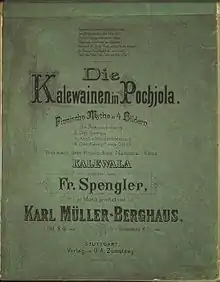| Die Kalewainen in Pochjola | |
|---|---|
| Romantic German opera by Karl Müller-Berghaus | |
 Score cover. | |
| Translation | The men of Kaleva in the Northland |
| Other title | Kalevalaiset Pohjolassa |
| Librettist | Fritz W. O. Spengler |
| Language | German |
| Based on | Kalevala |
| Premiere | 28 February 2017 Turku, Finland |
| Website | http://www.kalewainen.fi/ |
Die Kalewainen in Pochjola: Finnische Mythe in 4 Bildern frei nach dem Finnischen National-Epos Kalewala (German: “The men of Kaleva in the Northland: Finnish myths in four scenes freely from the Finnish national epic Kalevala”) is an 1890 German-Finnish opera in four acts composed by the German Karl Müller-Berghaus (1829–1907) to a libretto by Fritz W. O. Spengler, freely based upon Kalevala. Although using motifs and characters from a Finnish epic, the libretto is in German language. The style of the opera represents early Richard Wagner and the romantic German opera in general.[1]
The opera was composed in Turku, Grand Duchy of Finland, when Müller-Berghaus was working as an orchestral conductor for the Music Society of Turku. During the 19th and 20th century, the opera was never performed in toto; only the second act was given as a concert performance in Turku on 17 February 1890. The score is written for a relatively large orchestra, a chorus and seven lead roles, and there were no practical venues in that time for a full-scale performance. The première was planned at Hamburg State Opera in 1892 but because of an epidemic of cholera it never realized.[1]
The orchestral score and the piano score of the opera were published in Stuttgart circa 1892, but Die Kalewainen in Pochjola fell slowly into oblivion. A copy of the score was discovered in Turku in 2013 and it was decided to première the opera in February 2017.[1]
The opera has four acts:
- Die Brautwerbung (The proposal to the bride)
- Der Sampo (The Sampo)
- Achtis Wiederbelebung (Resurrecting Ahti)
- Der Kampf um’s Glück (The fight for luck).
The leading roles are Wäinämöinen, Ilmarinen, Achti alias Lemminkäinen, Luonnotar, Louchi, Ismo and a Magician (Zauberer).
When analyzing the score in 1933, the composer Sulho Ranta thought that the libretto was weak and the music was impersonal and derivative.[2]
References
- 1 2 3 Die Kalewainen in Pochjola: 127 vuotta kadoksissa ollut ooppera ensi-iltaan Turussa Suomi 100 -juhlavuonna. Archived 2016-03-06 at the Wayback Machine City of Turku, 29 February 2016. (in Finnish)
- ↑ Ranta, Sulho: “Ensimmäinen Kalevala-aiheinen ooppera: Karl Müller-Berghaus: ’Die Kalewainen in Pochjola’ (Kalevalaiset Pohjolassa).” Kalevalaseuran vuosikirja 13, pp. 202–231. Porvoo: WSOY, 1933. (in Finnish)